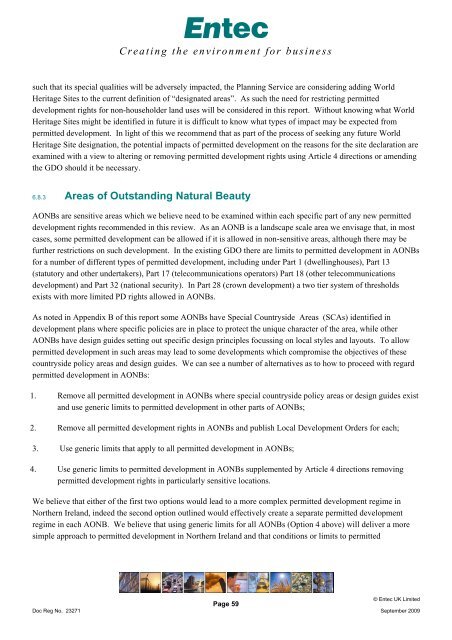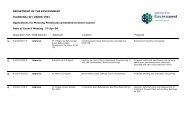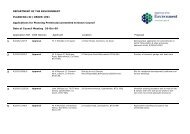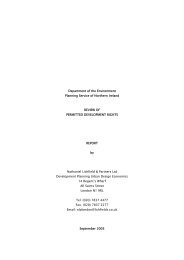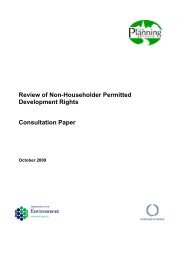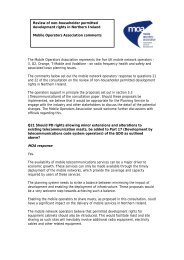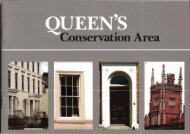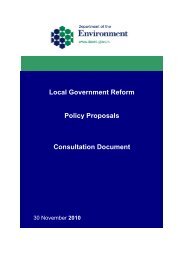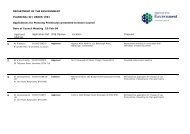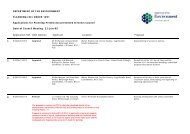Non-householder - Report - The Planning Service
Non-householder - Report - The Planning Service
Non-householder - Report - The Planning Service
You also want an ePaper? Increase the reach of your titles
YUMPU automatically turns print PDFs into web optimized ePapers that Google loves.
Creating the environment for business<br />
such that its special qualities will be adversely impacted, the <strong>Planning</strong> <strong>Service</strong> are considering adding World<br />
Heritage Sites to the current definition of “designated areas”. As such the need for restricting permitted<br />
development rights for non-<strong>householder</strong> land uses will be considered in this report. Without knowing what World<br />
Heritage Sites might be identified in future it is difficult to know what types of impact may be expected from<br />
permitted development. In light of this we recommend that as part of the process of seeking any future World<br />
Heritage Site designation, the potential impacts of permitted development on the reasons for the site declaration are<br />
examined with a view to altering or removing permitted development rights using Article 4 directions or amending<br />
the GDO should it be necessary.<br />
6.8.3 Areas of Outstanding Natural Beauty<br />
AONBs are sensitive areas which we believe need to be examined within each specific part of any new permitted<br />
development rights recommended in this review. As an AONB is a landscape scale area we envisage that, in most<br />
cases, some permitted development can be allowed if it is allowed in non-sensitive areas, although there may be<br />
further restrictions on such development. In the existing GDO there are limits to permitted development in AONBs<br />
for a number of different types of permitted development, including under Part 1 (dwellinghouses), Part 13<br />
(statutory and other undertakers), Part 17 (telecommunications operators) Part 18 (other telecommunications<br />
development) and Part 32 (national security). In Part 28 (crown development) a two tier system of thresholds<br />
exists with more limited PD rights allowed in AONBs.<br />
As noted in Appendix B of this report some AONBs have Special Countryside Areas (SCAs) identified in<br />
development plans where specific policies are in place to protect the unique character of the area, while other<br />
AONBs have design guides setting out specific design principles focussing on local styles and layouts. To allow<br />
permitted development in such areas may lead to some developments which compromise the objectives of these<br />
countryside policy areas and design guides. We can see a number of alternatives as to how to proceed with regard<br />
permitted development in AONBs:<br />
1. Remove all permitted development in AONBs where special countryside policy areas or design guides exist<br />
and use generic limits to permitted development in other parts of AONBs;<br />
2. Remove all permitted development rights in AONBs and publish Local Development Orders for each;<br />
3. Use generic limits that apply to all permitted development in AONBs;<br />
4. Use generic limits to permitted development in AONBs supplemented by Article 4 directions removing<br />
permitted development rights in particularly sensitive locations.<br />
We believe that either of the first two options would lead to a more complex permitted development regime in<br />
Northern Ireland, indeed the second option outlined would effectively create a separate permitted development<br />
regime in each AONB. We believe that using generic limits for all AONBs (Option 4 above) will deliver a more<br />
simple approach to permitted development in Northern Ireland and that conditions or limits to permitted<br />
Doc Reg No. 23271<br />
Page 59<br />
© Entec UK Limited<br />
September 2009


